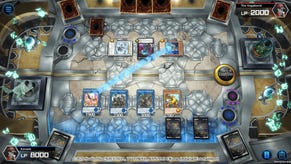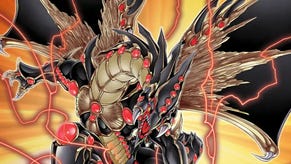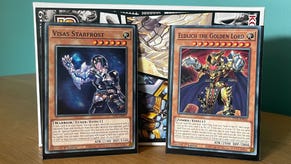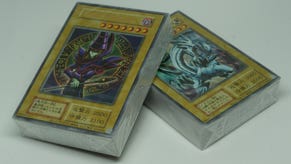What’s the future of Yu-Gi-Oh? We go hands-on with the TCG’s latest video games at TGS to find out
Master Duel, Duel Links, Cross Duel and Rush Duel impressions from this year’s Tokyo Game Show.
The simplicity yet tactical density of the Yu-Gi-Oh! card game has been a core part of the game’s appeal since the beginning, and is a big reason the TCG has endured around the world for 20 years. From the simplistic beatdown summoning decks of the game’s early days to the intricate archetype effect-driven strategies with heavy amounts of special summons that define the modern game, a big part of why this game remains so beloved is how it never stays the same for very long, constantly evolving and experimenting with new card types and even all-new ways to duel.
Yet times are changing. Alongside showcasing upcoming video game releases like Super Bomberman R 2, Konami used the space in its booth at Tokyo Game Show to showcase an experiment for the future of Yu-Gi-Oh! Of course, video games and Yu-Gi-Oh! have been inextricably linked since the beginning, with virtual simulators and gaming adaptations existing almost as long as the card game itself. Yet rarely have they varied so wildly as they have with the four titles Konami staged as its vision of the multimedia franchise at TGS: Master Duel, Duel Links, Cross Duel and Rush Duel.
Yu-Gi-Oh! Master Duel

For those who keep their playtime with the Yu-Gi-Oh! TCG in the strictly physical realm of traditional play, Master Duel is the closest approximation of the game they know and love in a digital form. The game enjoyed one of the most popular booths at Konami’s stand at the event - although I imagine this was less for the opportunity to play the tutorial of an already-released title and more for the chance to feel as though you’re playing in an actual futuristic duel simulator. (You can actually buy the setup for yourself, but it won’t come cheap!)
Master Duel is the closest approximation of the physical card game in a digital form.
The tried-and-tested formula of Master Duel shows that if it ain’t broke, don’t fix it, instantly finding success by appealing both to the nostalgic fans of yesterday looking for a digital-first reintroduction to the TCG and older fans who clamoured for an official simulator without the gimmicks. Konami has been quick to laud this game’s massive player base, and the game has retained a decent level of popularity even after the initial excitement surrounding the title fell away.
That being said, it’s unclear where Konami sees the game in its long-term strategy in spite of its popularity and presence at TGS. It’s clear the company seeks not to cannibalise the market for its physical TCG by keeping the card pool and ban list for the app separate to that of the real thing (the game only recently introduced cards like Spellbook of Judgment, originally released in 2013’s Lord of the Tachyon Galaxy), but what this means for the game’s long-term future remains unclear. The impressive and popular showcase shows Master Duel isn’t going anywhere anytime soon, but where Konami views the title in its long-term vision for the franchise alongside other formats and the physical TCG remains to be seen.
Yu-Gi-Oh! Duel Links

Yu-Gi-Oh! Duel Links, on the other hand, shows the benefits of breaking the rules to suit a new audience while adapting to modern digital platforms. Its initial release in 2016 acted as the first-ever introduction of an all-new format to the game with the inauguration of Speed Duels. Skill cards, smaller decks and a faster play style resulted in a flashier format than what many were used to before, while creating a more unpredictable format where a single monster effect or counter could turn the tide of battle.
Every aspect of the game is adapted to the mobile devices for which it was developed, with faster duels allowing players to experience a complete duel in the span of a short train or bus journey. A smaller field reduced from five monsters to three also makes it easier to experience the game in the palm of your hand. If that wasn’t enough, the ability to craft a new style of duel allowed Konami to craft it to player expectations of free-to-play mobile gameplay, with regular events.
This made its presentation on a large screen inside the Konami booth an eye-catching experience. Flashy animations dazzled on the giant screens embalmed into the walls of the booth, controlled with a large baton that wouldn’t be too far out of place in a school. It was easy to see the appeal of the game for long-time players when introduced in this vein, as you could quickly breeze through a duel within the brief time available while crushing opponents with your deck of choice. Kaiba’s Blue-Eyes White Dragon made light work of Joey Wheeler in my hands.
Capitalising on this success, Konami looks to build on this digital popularity as a gateway into physical card collecting. Alongside rule changes are Speed Duel-specific cards only valid for this mode - Speed Duel monsters don’t even have defense points - produced in all-new booster packs released side-by-side with the traditional format.
Although the experiment remains in its early stages, with the first release starting in 2019, the hope is that bringing these digital players into the real world will foster a long-term habit of collecting both Speed Duel and traditional cards. Should it succeed, this diversification should solidify the physical card game long-term in the digital age.
Yu-Gi-Oh! Cross Duel

Adapting the Speed Duel rules of Duel Links to the physical realm is simple. After sitting down with Yu-Gi-Oh! Cross Duel at Tokyo Game Show, it’s hard to imagine a similar transition capturing this surprisingly frantic and fun take on the TCG.
It’s hard to imagine Cross Duel working as well in person.
Cross Duel exists as a four-player interpretation of the traditional game, with all players taking turns and attacking at the same time, rather than something entirely original as seen with other titles. Sat at a table with three strangers in a similar quadrant system to the in-game duel field, we each chose a deck inspired by famous duelists from the history of the anime to duke it out for supremacy.
Cross Duel’s biggest departure from Yu-Gi-Oh!’s traditional ruleset is that it is no longer necessary to tribute your monsters to bring out many of your biggest threats. Elemental HERO Neos was easily brought into the fray on my very first turn with only a vague understanding of the rules, and I had a full field in play by the time we entered the battle phase. To counter this, positioning is key to success, as whichever of the three monster zones you place your card in determines who you will duel as it proceeds along a set path.
All four duelists can meet in the middle for an all-out assault or to attack the life points of the opponent opposite, or you can place it to the zones on either side to attack just a single monster en route to opponents either side. Rather than merely overcoming a weaker monster, however, the monster’s defeat reduces your attack by an equivalent amount. A 2500 ATK Neos can continue to attack your opponent’s life points after overcoming a 1900 ATK threat, but will only have 600 ATK remaining to damage your opponent. Once one opponent has had their life points reduced to zero, the duel ends that turn, and the duelist with the highest life points wins.
It’s a complex system unlikely to make a similar physical jump, yet surprisingly intuitive and fun within the digital realm. Having only been released mere days before the event it's hard to say whether the game can survive long-term, yet it stands as collaborative multiplayer duelling chaos that, should it succeed, should provide mindless fun for those who play it.
Yu-Gi-Oh Rush Duel: Dawn of the Battle Royale - Let's Go! Go Rush!!

The success of Yu-Gi-Oh! has always intertwined with its anime popularity, both internationally and in Japan. Yet for all the gimmicks of card games on motorcycles or new summoning mechanics these series have introduced, they have still remained within the confines of the traditional format playstyle. With Yu-Gi-Oh! Sevens, Konami moved the animated series into the realm of an all-new play style, something that the company has continued with an anime sequel, video games and physical trading cards that facilitate this new way to play.
The popularity of new formats and play styles suggest Yu-Gi-Oh! shows no sign of slowing down.
With Master Duel being more of a TCG simulator than a story-driven adventure, and Duel Links and Cross Duel being free-to-play mobile experiences at their core, Yu-Gi-Oh Rush Duel: Dawn of the Battle Royale - Let's Go! Go Rush!! is a story-driven console title adapted from the anime. It’s actually the second Rush Duel game the company has released and expands upon the offerings of that game while offering part of the title in a special free-to-play limited form.
The game incorporates the all-new ruleset the format follows: three monster zones per player, no Pendulum Zones, no limit on summons per turn and Maximum Monsters - special monsters that can only be summoned when all three monsters in the set are in your hand, allowing them to be summoned to the field simultaneously - among others.
Rush Duel is set for release in December, making its TGS demo a first public look at the new game. Following the story of the newest Yu-Gi-Oh! anime, we follow students Yuhi and Yaomu who meet the mysterious Yudias, an alien who has come to Earth seeking the future. For those who hadn’t guessed, the future is Rush Duel. The early duel offered in the demo was a showcase of this ‘future’, with no expense spared on flashy visual effects to make the duel exciting. Unfortunately, I lost.
Rush Duel has been a success for Konami. The first game incorporating the format sold well in Japan following its release on Nintendo Switch in 2021, one year after the anime's first broadcast, and the production of physical cards to coincide with the anime and game’s release have continued for over two years. These cards feature an all-new design with more eye-catching artwork and easier-to-understand effects, bringing in a younger audience not yet familiar with the game. The physical cards are yet to be made available in English, with Konami instead focusing its efforts on Speed Duel in regions outside of Japan and Korea (beyond the first Switch game’s international release in December last year).

The popularity of new formats and play styles, particularly with Rush Duel in Japan, suggest Yu-Gi-Oh! shows no sign of slowing down, with the card game’s Tokyo Game Show a look to the future rather than a celebration of the past. Still, one glimpse at the reasons for Yu-Gi-Oh!’s recent success sees much of this growth coming from a necessary diversification away from the traditional format which leaves questions over its place in the future of the franchise.
Master Duel is a unique digital take on traditional play, with different card selection and ban lists framing the same slower, methodical play the game has embraced for decades. But Duel Links showed players are happy to try new takes on the game, something taken to the next level with Rush Duel and Cross Duel as Konami is seeking to establish a more profitable and varied future for the game. Most importantly, for those who’ve stuck with the game for all these years, this is all happening without a reduction in support or care for the traditional format.
The experiment is admirable. We’ll have to see if it pays off.












